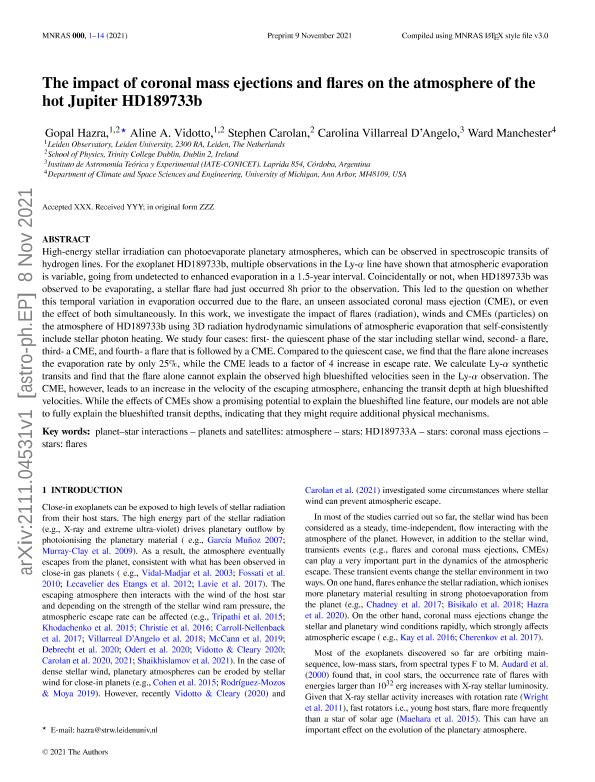Artículo
The impact of coronal mass ejections and flares on the atmosphere of the hot Jupiter HD189733b
Hazra, Gopal; Vidotto, Aline A.; Carolan, Stephen; Villarreal D'angelo, Carolina Susana ; Manchester, Ward
; Manchester, Ward
 ; Manchester, Ward
; Manchester, Ward
Fecha de publicación:
02/2022
Editorial:
Wiley Blackwell Publishing, Inc
Revista:
Monthly Notices of the Royal Astronomical Society
ISSN:
0035-8711
Idioma:
Inglés
Tipo de recurso:
Artículo publicado
Clasificación temática:
Resumen
High-energy stellar irradiation can photoevaporate planetary atmospheres, which can be observed in spectroscopic transits of hydrogen lines. For the exoplanet HD189733b, multiple observations in the Ly α line have shown that atmospheric evaporation is variable, going from undetected to enhanced evaporation in a 1.5-yr interval. Coincidentally or not, when HD189733b was observed to be evaporating, a stellar flare had just occurred 8 h prior to the observation. This led to the question of whether this temporal variation in evaporation occurred due to the flare, an unseen associated coronal mass ejection (CME), or even the simultaneous effect of both. In this work, we investigate the impact of flares (radiation), winds, and CMEs (particles) on the atmosphere of HD189733b using three-dimensional radiation hydrodynamic simulations that self-consistently include stellar photon heating. We study four cases: first, the quiescent phase including stellar wind; secondly, a flare; thirdly, a CME; and fourthly, a flare that is followed by a CME. Compared to the quiescent case, we find that the flare alone increases the evaporation rate by only 25 per cent, while the CME leads to a factor of 4 increments. We calculate Ly α synthetic transits and find that the flare alone cannot explain the observed high blueshifted velocities seen in the Ly α. The CME, however, leads to an increase in the velocity of escaping atmospheres, enhancing the blueshifted transit depth. While the effects of CMEs show a promising potential, our models are not able to fully explain the blueshifted transit depths, indicating that they might require additional physical mechanisms.
Archivos asociados
Licencia
Identificadores
Colecciones
Articulos(IATE)
Articulos de INST.DE ASTRONOMIA TEORICA Y EXPERIMENTAL
Articulos de INST.DE ASTRONOMIA TEORICA Y EXPERIMENTAL
Citación
Hazra, Gopal; Vidotto, Aline A.; Carolan, Stephen; Villarreal D'angelo, Carolina Susana; Manchester, Ward; The impact of coronal mass ejections and flares on the atmosphere of the hot Jupiter HD189733b; Wiley Blackwell Publishing, Inc; Monthly Notices of the Royal Astronomical Society; 509; 4; 2-2022; 5858-5871
Compartir
Altmétricas



